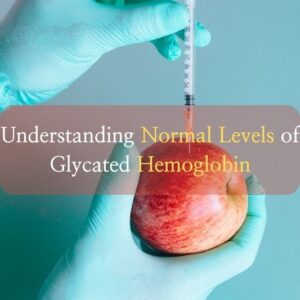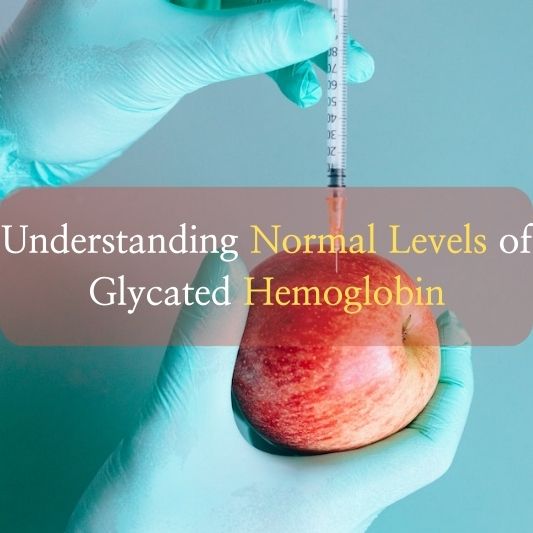In the world of healthcare, understanding the normal levels of glycated hemoglobin (HbA1c) is paramount. This simple blood test can provide valuable insights into a person’s long-term blood sugar control. Whether you’re a healthcare professional or someone interested in managing their diabetes, this article will break down the importance of HbA1c, its significance, and what normal levels mean for your health.

What is Glycated Hemoglobin?
Glycated hemoglobin, often referred to as HbA1c, is a molecule that forms when hemoglobin (the protein in red blood cells responsible for carrying oxygen) combines with glucose in the bloodstream. This process, called glycation, occurs over time as red blood cells circulate in your body. The amount of HbA1c in your blood is a reflection of your average blood sugar levels over the past two to three months.
The Significance of HbA1c
Maintaining normal levels of HbA1c is crucial for individuals with diabetes or those at risk of developing the condition. Here’s why it matters:
Long-term Blood Sugar Control
HbA1c provides a comprehensive view of your blood sugar control, unlike daily glucose measurements that can fluctuate. It helps healthcare professionals assess how well you’ve managed your blood sugar over an extended period.
Risk Assessment
By monitoring HbA1c levels, doctors can determine your risk of diabetes-related complications. Elevated levels may indicate an increased risk of heart disease, kidney problems, and nerve damage.
Treatment Adjustments
For those already diagnosed with diabetes, HbA1c levels guide treatment decisions. If your levels are consistently high, your healthcare team may adjust your medication or recommend lifestyle changes to improve your blood sugar control.
Normal HbA1c Levels
Normal levels of glycated hemoglobin can vary slightly depending on the laboratory and the units used for measurement. However, in general, the following guidelines are considered standard:
- HbA1c below 5.7%: This is typically considered normal and indicates a low risk of diabetes.
- 5.7% to 6.4%: This range suggests prediabetes, a condition where blood sugar levels are elevated but not high enough to be classified as diabetes.
- 6.5% or higher: An HbA1c level of 6.5% or above often indicates diabetes.
It’s important to note that individual targets may vary based on a person’s specific health circumstances, age, and other factors. Always consult with your healthcare provider to determine the most appropriate target for you.
Achieving and Maintaining Normal HbA1c Levels
If you’ve been diagnosed with prediabetes or diabetes, achieving and maintaining normal HbA1c levels should be a primary goal. Here are some steps you can take:
Blood Sugar Monitoring
Regularly monitor your blood sugar levels at home, as advised by your healthcare provider. This can help you understand how your daily activities and diet affect your blood sugar.
Medication and Insulin
If prescribed, take your medications or insulin as directed. Consistency is key to managing blood sugar effectively.
Lifestyle Changes
Make healthy lifestyle choices, including a balanced diet, regular physical activity, and stress management. These factors play a significant role in blood sugar control.
Regular Check-ups
Visit your healthcare provider regularly to track your HbA1c levels and make necessary adjustments to your treatment plan.
Conclusion
In conclusion, understanding normal levels of glycated hemoglobin (HbA1c) is vital for individuals with diabetes or those at risk of developing the condition. Maintaining normal HbA1c levels is a key component of diabetes management and can help reduce the risk of complications. Remember to work closely with your healthcare provider to establish and achieve your specific HbA1c targets.
FAQs
Q1. What is the ideal HbA1c target for someone with diabetes?
The ideal HbA1c target may vary from person to person. It’s typically recommended to aim for an HbA1c level below 7%, but individualized targets may be set by your healthcare provider based on your health status and age.
Q2. Can HbA1c levels be improved through diet and exercise alone?
In some cases, lifestyle changes like a healthy diet and regular exercise can help improve HbA1c levels, especially in individuals with prediabetes. However, many people with diabetes will also require medication or insulin therapy.
Q3. How often should I have my HbA1c levels checked?
The frequency of HbA1c checks can vary, but it’s typically done every three to six months for individuals with diabetes. Your healthcare provider will determine the most appropriate schedule for you.
Q4. Are there any natural supplements that can lower HbA1c levels?
Some natural supplements, such as cinnamon and chromium, have shown potential in helping to lower blood sugar levels. However, it’s essential to consult with your healthcare provider before adding any supplements to your regimen.
Q5. What are the symptoms of high HbA1c levels?
High HbA1c levels may be associated with symptoms like increased thirst, frequent urination, fatigue, and blurred vision. However, many individuals with elevated HbA1c levels may not experience noticeable symptoms, underscoring the importance of regular testing.
Find out the price of blood sugar control aids on iHub!
